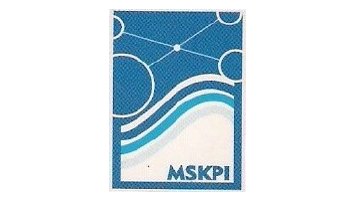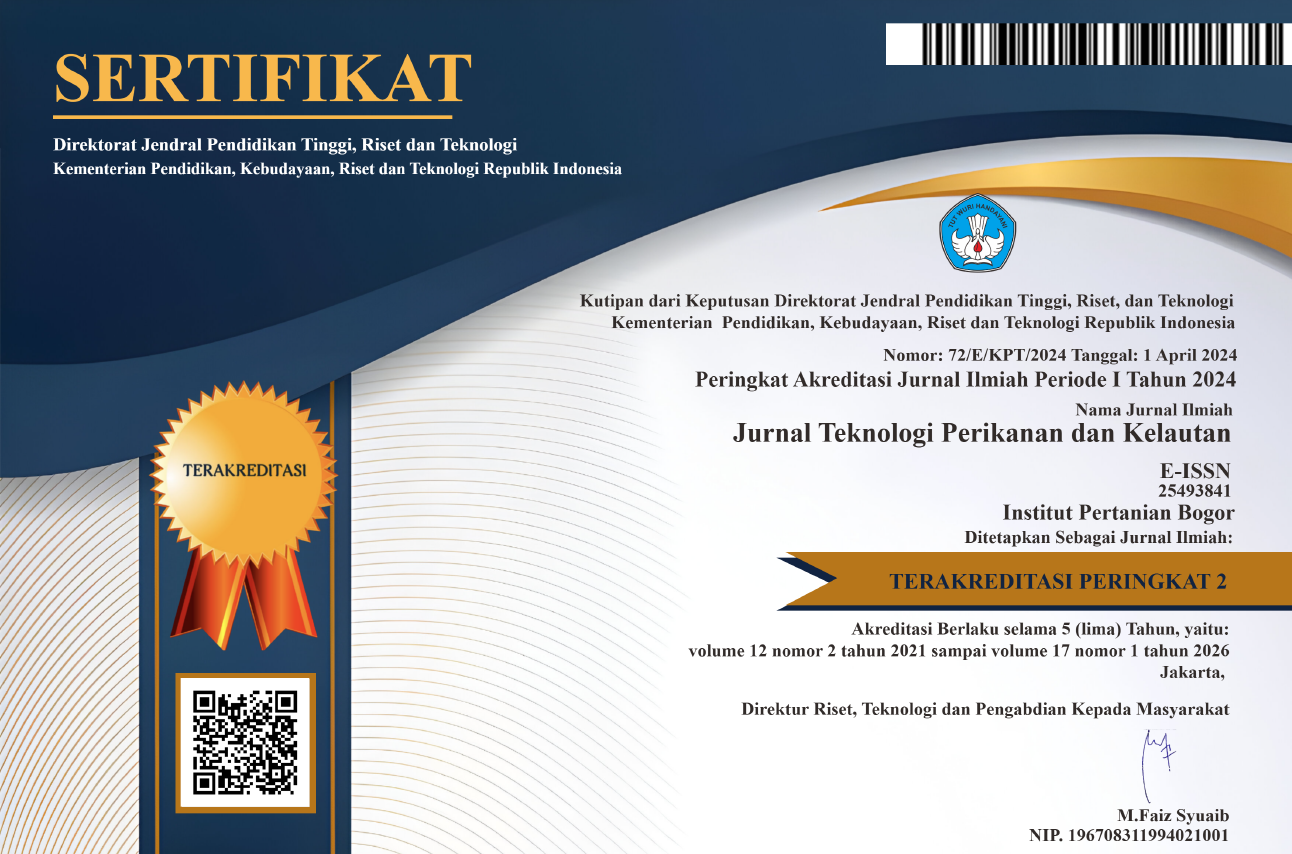Author Guidelines
GENERAL REQUIREMENTS
- Acceptable articles are research results or research techniques related to fisheries and marine technology.
- Articles must be original writings of the last 10 years (never before or in the process of being published in national or international scientific journals).
- Articles are written in English or Indonesian, using Microsoft Word.
- The authors must clearly state the correspondent author's name, full address, and email address.
- The correspondent author is responsible for the originality of the research and the content of the manuscript. Other authors must have approved the submitted manuscript.
- Files containing manuscripts and article submission forms can be sent through the website of Jurnal Teknologi Perikanan dan Kelautan: http://journal.ipb.ac.id/index.php/jtpk/about/submissions
- Manuscripts outside these provisions will not be accepted.
WRITING FORMAT
1. Articles are typed in 2 spaces on A4 size paper with one column format and 2 cm margins on each side. The font used is Bookman Old Style size 10 pt. Articles should not exceed 20 pages.
2. Include page numbers on the bottom right starting with page 1 in the title section.
3. Inclusion of scientific names in Latin binomial or trinomial form (in italics), used to clarify the description of the organism in question. The inclusion of common scientific names is not required. The full scientific name is written the first time it is mentioned in the text, each figure, and each table.
4. International System (SI) units, including those derived, must be used. Use a slash to indicate a ratio. Example: (gram/mol instead of gram.mol-1)
5. Abbreviations and symbols used are those commonly used, especially in scientific societies. Other abbreviations may be used if each abbreviation is given its extension when first mentioned in the article.
6. Write numbers one to ten and units of measurement (5 g, 20 fish). Do not start a sentence with a number. Use 5.000 instead of 5000, and 5% instead of 5 per cent.
7. Write the date using the day month year order (e.g. 10 June 1992).
8. Every reference cited in the manuscript must be included in the bibliography, and vice versa (always need to be corrected both spelling and year).
9. In-text citations follow the following rules:
- Single author: Sudirman (1995) or (Sudirman 1995).
- Two authors: Sudirman dan Budiman (1995) or (Sudirman dan Budiman 1995).
- Three or more authors: Sudirman et al. (1995) or (Sudirman et al. 1995).
- It is strongly discouraged to use quotations from unpublished references or based on personal communication.
- Use parentheses and separate them with semicolons to mention multiple literature references, tables, and figures. Example: (Sudirman 1992; Budiman 1995) (Table 1; Figure 2). Sort the references starting from the oldest year.
10. The chapters of the manuscript such as introduction, methods, results and discussion, conclusion, acknowledgments (optional), and references are written in the middle of the page (alignment center). All letters are written in uppercase and bold.
11. Subchapters are written in capital letters at the beginning of the sentence (sentence case), bold, and positioned on the left side of the page (alignment left). While subsections are not bold, but italicized.
ARTICLE STRUCTURE
TITLE
- The title is written in Indonesian and English, with Indonesian first and English second for Indonesian manuscripts. The title should be concise, straightforward, specific, and informative, in accordance with the theme of the manuscript. The maximum length of the Indonesian title is 15 words.
- Write the title in the middle of the page (alignment center) at the top with capital letters except scientific names.
AUTHOR'S NAME AND INSTITUTION
Include the author's name and institution (written in full) after the title section.
Example: First Author1*, Second Author2, ...... and so on (Add '*' sign for correspondence author)
1Institution of the First Author (name of department/study program and faculty (if any), name of institution, along with full address and postcode)
2Second Author's Institution (name of department/study program and faculty (if any), name of institution, along with full address and postcode)
3.............................., and so on
*Correspondence: email address of the correspondence author: email@email.com
ABSTRACT
The Abstract is written in two languages (Indonesian and English) with a maximum of 250 words, including a brief introduction, research objectives, methods, results, and conclusions in a concise and clear manner. Avoid the use of abbreviations except those that are commonly used or have been previously mentioned.
KEYWORDS
Written in Indonesian and English, maximum 5, arranged in alphabetical order from the beginning of the word.
INTRODUCTION
The introduction contains the background or strong reasons for conducting the research, objectives, and hypotheses if any. Use literature that really supports the discussion in the article.
METHOD
Methods can include laboratory experiments, field experiments, and field surveys designed according to the purpose or type of research. Previously published methods should be written as literature, only relevant modifications should be described. The research method can be divided into several subchapters according to the details of the steps of the scientific work, for example: materials, equipment, data analysis.
RESULTS AND DISCUSSION
Present the results of the research first, giving sufficient explanation for important findings, followed by analysis and then discussion. Subchapters in the results and discussion are developed systematically and lead to conclusions.
CONCLUSION
The conclusion is an answer to the research objectives and not a summary of the results obtained.
ACKNOWLEDGEMENTS (if any)
This section can be used to express gratitude to funders or parties (institutions/personnel) who have collaborated or contributed.
REFERENCES
The references should be arranged alphabetically from the first author. If there are two or more publications from the same author in the same year, then the year of publication of the publication is added with a small letter that can distinguish (for example: Suwanto A. 2001a; Suwanto A. 2001b). JTPK suggest authors use reference manager applications, such as Mendeley, EndNote, Zotero, etc., to prepare citations and the list of references. The writing of the references must follow the rules as exemplified below:
- TABLE
Tables must be referenced in the text. The table title is written above the table, with capital letters at the beginning of the first word only (sentence case), Bookman Old Style 9 pt, left-aligned, not bolded, and ends with a period (.). The table title must be clear, stand-alone, and provide information about the table so that the reader can understand without reading the body of the text.
- IMAGES
Images must be referenced in the text. Images don't need to use a border. The image title is written below the image with capital letters at the beginning of the first word only (sentence case), Bookman Old Style 9 pt, not bolded, and ends with a period (.), if the image title consists of one line then use center alignment, while if the image title is more than one line, then use left alignment. The image title must be clear, stand-alone, and provide information about the image so that the reader can understand without reading the body of the text.
















